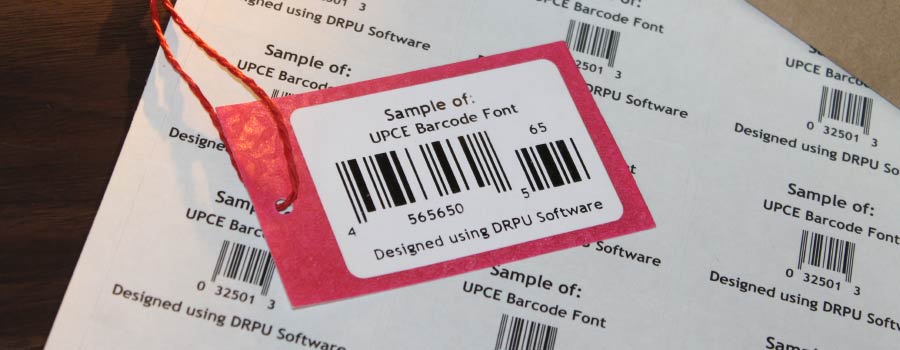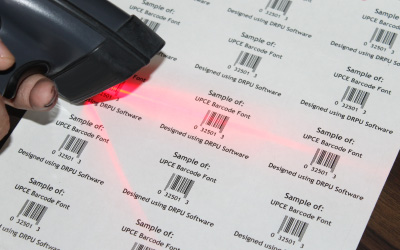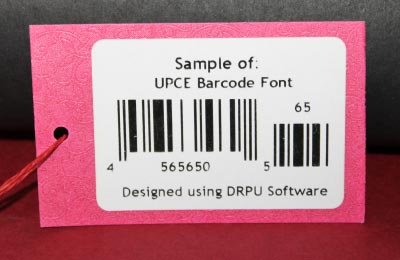✠ Related Articles
Download and Install UPCE Barcode Software
Some Related Points of UPCE Barcode
-
► In order to understand how the UPCE barcode works, it is important to first understand the basic structure of the UPC barcode. A standard UPC barcode consists of three main components: the manufacturer code, the product code, and the check digit.
-
► In the case of the UPCE barcode, the manufacturer code and the product code are combined and compressed into a single 8-digit number. This compression is achieved through a process known as zero suppression. The first digit of the product code is used to determine which zeros can be safely suppressed. If the first digit is a 0, 1, 2, 3, or 4, then the second, third, and fourth digits can be suppressed. If the first digit is a 5, 6, 7, 8, or 9, then the third and fourth digits can be suppressed.
-
► Once the product code has been compressed using zero suppression, the check digit is calculated using the same algorithm as the standard UPC barcode. This check digit is then added to the end of the compressed product code to form the final UPCE barcode.
-
► The use of UPCE barcodes has several advantages over standard UPC barcodes. First, the smaller size of the barcode allows for more products to be stored in a smaller amount of space. This can be particularly useful in retail settings where space is at a premium. Additionally, the use of zero suppression can help to reduce the risk of errors when entering the barcode into a system. Since leading zeros are often unnecessary, their removal can help to streamline the process of entering product codes.
-
► However, there are also some disadvantages to using UPCE barcodes. One potential issue is that the compressed product code may not be unique across all products. This is because the compressed product code is only 6 digits long, whereas the standard product code is 5 digits long. As a result, there is a greater likelihood of two products having the same compressed product code. To address this issue, some companies may use a combination of the UPCE and standard UPC barcodes to ensure that each product has a unique identifier.
In conclusion, the UPCE barcode is a compressed version of the standard UPC barcode that is commonly used in retail settings. It is created through a process known as zero suppression, which involves removing leading zeros from the product code. While the use of UPCE barcodes can have several advantages, it is important to be aware of the potential issues associated with their use, such as the possibility of duplicate product codes. Overall, UPCE barcodes are a useful tool for tracking and identifying products in a retail setting, and their use is likely to continue to grow in the future.
The Structure of a UPCE Barcode

The structure of a UPCE barcode is a compressed version of the Universal Product Code (UPC) barcode, which is commonly used to identify and track products in retail settings. The UPCE barcode is created by compressing the 12 digits of the standard UPC barcode into an 8-digit code through a process known as zero suppression. This compressed code includes a manufacturer code, a product code, and a check digit, which are used to uniquely identify the product.
-
The first step in understanding the structure of a UPCE barcode is to understand the structure of a standard UPC barcode. A standard UPC barcode consists of three main components: the manufacturer code, the product code, and the check digit.
-
The manufacturer code is a unique identifier assigned to the company that produces the product. It is typically a 6-digit number, although it can be longer in some cases. The product code is a unique identifier assigned to the specific product. It is typically a 5-digit number, although it can be longer in some cases. The check digit is a single digit that is used to verify the accuracy of the barcode. It is calculated based on a specific algorithm using the other digits in the barcode.
-
The structure of a UPCE barcode is similar to that of a standard UPC barcode, but with some key differences. The UPCE barcode only has 8 digits, compared to the 12 digits of a standard UPC barcode. This compression is achieved through a process known as zero suppression, which involves removing leading zeros from the product code.
-
The compressed product code in a UPCE barcode consists of two main parts: the UPC number system digit and the product number. The UPC number system digit is a single digit that indicates the format of the barcode. In the case of the UPCE barcode, the UPC number system digit is always zero.
-
The product number in a UPCE barcode is a compressed version of the product code in a standard UPC barcode. The product number consists of five digits, with the first digit indicating the type of product being sold. The remaining four digits are the actual product code.
-
The compression of the product code is achieved through zero suppression, which involves removing leading zeros from the product code. The rules for zero suppression in a UPCE barcode are based on the value of the first digit of the product code. If the first digit is between 0 and 4, then the second, third, and fourth digits can be suppressed. If the first digit is between 5 and 9, then the third and fourth digits can be suppressed. The result is a compressed product code that is only 6 digits long.
-
Once the compressed product code has been created, the check digit is calculated using the same algorithm as in a standard UPC barcode. The check digit is a single digit that is used to verify the accuracy of the barcode. It is calculated by taking the sum of the odd-numbered digits and multiplying it by 3, then adding the sum of the even-numbered digits. The check digit is then the amount needed to round the total up to the next multiple of 10.
Finally, the UPC number system digit, the compressed product number, and the check digit are combined to create the final UPCE barcode. The resulting barcode is 8 digits long and is used to identify and track products in retail settings.
In conclusion, the structure of a UPCE barcode is a compressed version of the standard UPC barcode that includes a manufacturer code, a compressed product code, and a check digit. The compressed product code is created through a process known as zero suppression, which involves removing leading zeros from the product code. The resulting code is 6 digits long and includes a UPC number system digit and a compressed product number.
The Applications of UPCE Barcode
UPCE barcodes have a wide range of applications in various industries, including retail, healthcare, and logistics. Here are some of the most common applications of UPCE barcodes:

-
Retail:
UPCE barcodes are widely used in retail environments to identify and track products. By scanning the barcode, retailers can quickly retrieve information about a product, such as its price, description, and inventory status. UPCE barcodes are also used to facilitate transactions, as they can be scanned at the point of sale to quickly and accurately ring up purchases.
-
Healthcare:
In the healthcare industry, UPCE barcodes are used to identify and track medical devices, equipment, and pharmaceuticals. By scanning the barcode, healthcare providers can quickly access important information about a product, such as its expiration date, lot number, and manufacturer. This information can be critical in ensuring patient safety and preventing medication errors.
-
Logistics:
UPCE barcodes are used extensively in logistics and supply chain management to track the movement of products from one location to another. By scanning the barcode at various points in the supply chain, logistics providers can quickly and accurately track the movement of products, identify any delays or bottlenecks, and optimize their operations accordingly.
-
Inventory management:
UPCE barcodes are also commonly used for inventory management. By scanning the barcode of each item in a store or warehouse, retailers can quickly and accurately track their inventory levels and identify any discrepancies or shortages. This information can be used to optimize stock levels, reduce waste, and improve overall efficiency.
-
E-commerce:
UPCE barcodes are increasingly being used in e-commerce environments to streamline the online shopping experience. By including a UPCE barcode on each product, retailers can provide customers with detailed information about the product, such as its price, description, and availability. This information can be used to improve the customer experience and increase sales.
-
Asset tracking:
UPCE barcodes are also used for asset tracking in a variety of industries. By scanning the barcode of each asset, companies can quickly and accurately track the location, condition, and maintenance history of their assets, such as vehicles, equipment, and tools. This information can be used to optimize asset utilization, reduce downtime, and improve overall efficiency.
-
Document management:
UPCE barcodes can also be used for document management. By including a barcode on each document, companies can quickly and accurately track the location and status of their documents, such as contracts, invoices, and receipts. This information can be used to improve document organization, reduce the risk of lost or misplaced documents, and streamline document retrieval.
UPCE Barcode is Different from other Barcode Types
UPCE barcodes are a specific type of barcode that differs from other barcode types in several ways. Here are some of the key differences between UPCE barcodes and other barcode types:
-
Length:
UPCE barcodes are shorter than other barcode types, such as UPC-A barcodes. UPCE barcodes are only 6 digits long, while UPC-A barcodes are 12 digits long. This makes UPCE barcodes more space-efficient and allows them to be used on smaller products.
-
Check digit:
Unlike other barcode types, UPCE barcodes do not include a separate check digit in the barcode itself. Instead, the check digit is derived from the 6-digit UPC code and is calculated by the barcode scanner when the code is scanned.
-
Product identification:
UPCE barcodes are primarily used for identifying consumer goods, such as groceries and household items. Other barcode types, such as Code 128 and Code 39, are more commonly used for industrial and logistics applications, such as tracking inventory and shipping products.
-
Scanning:
UPCE barcodes can be scanned using the same type of barcode scanner as other barcode types, but they require a different scanning algorithm. Because UPCE barcodes are shorter and use a unique encoding scheme, barcode scanners must be able to recognize and decode UPCE barcodes specifically.
-
Encoding:
UPCE barcodes use a unique encoding scheme that differs from other barcode types. UPCE barcodes use a special algorithm to encode the 6-digit UPC code into a 12-digit barcode format. This encoding scheme allows for a more compact barcode that can be easily scanned and decoded by barcode scanners.
-
International use:
UPCE barcodes are primarily used in the United States and Canada, while other barcode types, such as EAN and Code 128, are more commonly used internationally. This is because UPCE barcodes were developed specifically for use in the North American market and are not recognized by all barcode scanners outside of this region.
The Minimum and Maximum Length of a UPCE Barcode
The minimum and maximum length of a UPCE barcode are both fixed and defined by the barcode specification.
UPCE barcodes are a subset of the Universal Product Code (UPC) barcode standard. Unlike the standard UPC-A barcode, which consists of 12 digits, a UPCE barcode has a fixed length of 6 digits. The shorter length of the UPCE barcode makes it more space-efficient and allows it to be used on smaller products.
The 6-digit code used in a UPCE barcode is derived from the 12-digit UPC-A code that identifies the same product. The 6-digit code is generated by dropping the leading zero and the check digit from the UPC-A code, and then using a specific algorithm to generate a compressed version of the remaining 10 digits.
The compressed 6-digit code is then used to create the final UPCE barcode. The barcode is composed of 6 bars and spaces, with each digit represented by a unique pattern of bars and spaces. The barcode is read from left to right, with the first two digits representing the manufacturer number, the next three digits representing the item number, and the final digit representing the check digit.
In summary, the minimum and maximum length of a UPCE barcode is fixed at 6 digits. This length is derived from the compression algorithm used to generate the barcode from the 12-digit UPC-A code that identifies the same product. The fixed length of the UPCE barcode makes it more efficient for use on smaller products, while still allowing for accurate and reliable identification and tracking of consumer goods.
